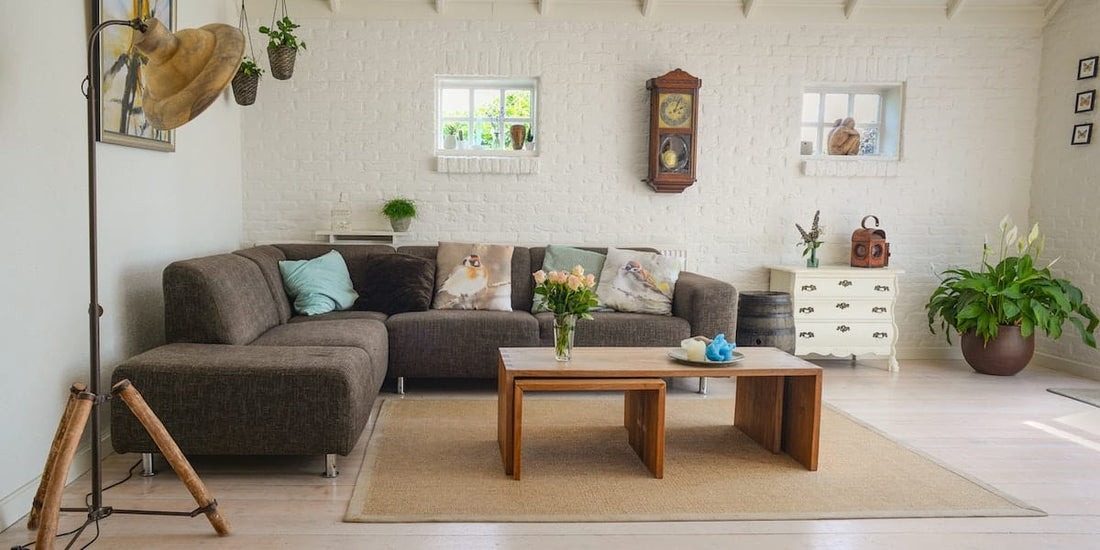Home and Decor
6 min read
Sustainable Home Decor: How to Style Your Space with Purpose and Impact
October 30 , 2025
By Lillian Ashbaugh

Home decor is more than just aesthetics; it is a combination of a number of different activities that are reflected in our values, lifestyle, and intentions. As environmental awareness continues to grow, so does the desire to design spaces that are both beautiful and kind to the planet, and thus, sustainable home decor offers a way to create inviting interiors without compromising environmental ethics or personal style. This ideology of home decor is particularly impactful when you are furnishing a new apartment, revamping a favorite room, or slowly curating your dream home, as choosing sustainable decor doesn’t mean sacrificing style. In fact, many eco-friendly materials and practices add a unique sense of warmth, texture, and authenticity that mass-produced items simply can't match, and the key lies in being intentional with your purchases, mindful in your choices, and thoughtful in your overall design approach.
In this blog, we will explore how you can efficiently decorate sustainably, which includes the materials you choose to the way you shop, so in retrospect, you can design a home that looks great, feels amazing, and makes a positive impact on the planet.
Choose Natural and Renewable Materials
When shopping for furniture and decor, the best action to perform while keeping sustainable decor in mind is to prioritize natural, renewable, and biodegradable materials. Some viable options for sustainable materials include wood, bamboo, rattan, cork, jute, organic cotton, hemp, linen, and wool, as these materials are sustainable because they regenerate quickly, are often biodegradable, and generally require fewer resources to produce than synthetic alternatives. FSC-certified wood ensures that forests are responsibly managed, and you can also look for certifications such as OEKO-TEX, GOTS (Global Organic Textile Standard), or GREENGUARD to ensure that textiles are free from harmful chemicals, as these certifications can guide you toward materials that are better for your home and for the planet. Moreover, not only are these materials more eco-conscious, but they also bring rich textures and an earthy warmth to your interiors, as a jute rug or a handwoven throw can completely transform a room into a cozy haven.
Buy Less, Choose Well
The idea of buying less but better is at the heart of sustainable living because instead of chasing seasonal decor trends that often lead to impulse buys and clutter, sustainable buying involves opting for high-quality, timeless pieces that will stand the test of time. Some good options include multifunctional furniture, classic silhouettes, and neutral palettes that can evolve with your style. To make the matter more easy and streamlined, you can ask yourself if you will love it in five years; or is it made from durable materials; or is it versatile enough to fit into different rooms or settings. When you answer these questions with utmost truth and conviction, you end up making mindful choices, which help you create an interior that is not only stylish but also deeply personal. Thus, this mindset also leads to less waste, a more cohesive aesthetic, and a deeper appreciation for the items you do bring into your home.
Embrace Secondhand and Vintage Finds
Shopping secondhand is one of the most sustainable ways to furnish and decorate your home as by giving pre-loved items a new life, you're reducing waste and conserving resources that would otherwise be used to produce something new. Additionally, vintage and antique pieces are effective at enhancing character, charm, and a sense of history that new items often lack. These items are particularly prevalent in thrift stores, flea markets, estate sales, and online marketplaces like Facebook Marketplace or Chairish, which are treasure troves for unique finds. When shopping, you must make sure to keep an open mind, as a little sanding, painting, or reupholstering can work wonders. Furthermore, you can also combine old with new, as that also creates a more layered and eclectic space, as a retro armchair paired with a modern coffee table or vintage artwork above a sleek sideboard can make your decor truly one-of-a-kind.
Support Local Artisans and Ethical Brands
Supporting local artisans and ethical brands is a highly recommended act, especially in sustainable decor, as when you shop small or buy from ethical brands, you support businesses that are more likely to prioritize fair labour practices, low-impact production, and handcrafted quality. Unlike mass-produced decor, artisan-made items often come with a motivational or inspiring story, and they can add depth and meaning to your home. These unique folk stories, deep philosophical feelings, and ruminative ideas are omnipotent in hand-thrown ceramic vases, macrame wall hangings, and even quilt stitched by a local maker, as these pieces often last longer and look better over time. Moreover, you are also helping to keep traditional skills and crafts alive, and to choose the right ones, you should take time to research the mission of the brands you buy from, as transparency about sourcing, manufacturing, and community impact is a good sign that a company truly values sustainability.
Opt for Non-Toxic Paint and Finishes
Paint is another major component of sustainable living as many paints, sealants, and finishes used in home decor contain volatile organic compounds (VOCs), which can release harmful chemicals into the air. To create a healthier living environment, and make your daily living more eco-friendly, you should choose low-VOC or zero-VOC paint brands and water-based finishes. Such premium, and even moderate-level brands offer non-toxic alternatives without compromising on colour, patterns, textures, and finishing. With their clean lining and fresh, healthy outlook, these choices improve indoor air quality and reduce your exposure to allergens and respiratory irritants. Furthermore, when refinishing furniture or floors, opt for natural oils and waxes instead of polyurethane-based products, as not only are they safer, but they also allow wood to age more gracefully and develop a beautiful patina over time.
Sustainable home decor isn’t about achieving perfection, but it is mainly about making conscious and meaningful choices that reflect your values and support the world around you. When you bring intention to your interior design, you shape a space that nurtures both people and the planet, and in this vision, every effort counts. Whether it’s choosing reclaimed wood over plastic, supporting an artisan instead of a factory, or growing your own herbs in the kitchen, these steps build a more thoughtful, sustainable home. In all these actions, with just a little mindfulness and creativity, your home can become more than just a stylish space, as it can be a sanctuary of purpose, personality, and positive impact. In the era of climate change and rising demands/trends of sustainable living, wow more than ever, design has become not just about how your home looks, but about how it makes you and the Earth feel.
live smarter
Shop smarter, live better, and stay ahead of the trends with our reliable recommendations!

Travel
6 min read
The Ultimate Travel Companion: Why Every Traveler Needs a Smart Luggage Set in 2025

Health and Beauty
5 min read
The Ultimate Guide to Beauty: Tips, Tricks, and Routines for Radiant Skin, Hair, and Confidence
trending
Home and Decor
5 min read
Home and Décor: Transforming the four walls into the ultimate self-expression
Home and Decor
6 min read
5 Must-Have Home Decor Items That Add Instant Charm
Home and Decor
6 min read
How to Maximize Small Spaces: 4 Clever Home & Decor Ideas for Compact Living
Home and Decor
6 min read
Transform Your Living Space: The Ultimate Guide to Home and Decor Inspiration
Home and Decor
6 min read




